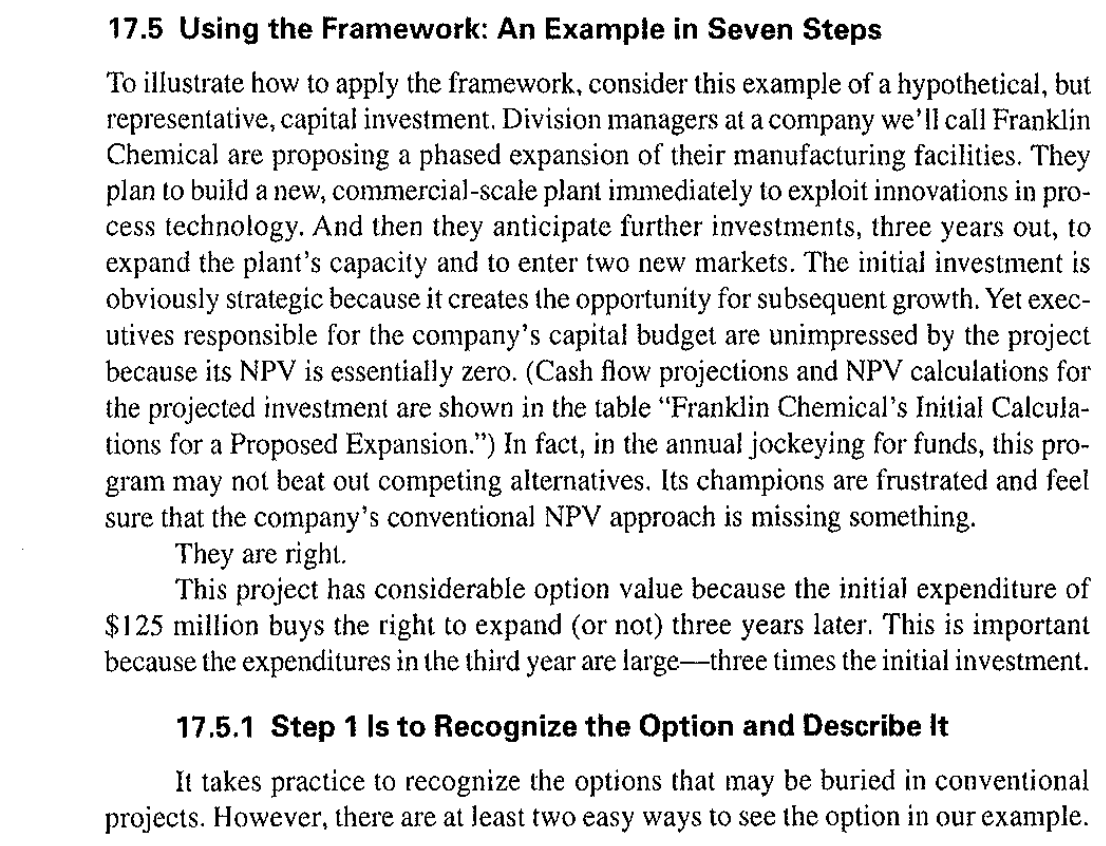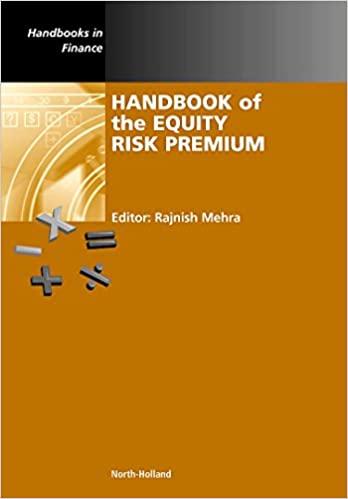



17.5 Using the Framework: An Example in Seven Steps To illustrate how to apply the framework, consider this example of a hypothetical, but representative, capital investment, Division managers at a company we'll call Franklin Chemical are proposing a phased expansion of their manufacturing facilities. They plan to build a new, commercial-scale plant immediately to exploit innovations in pro- cess technology. And then they anticipate further investments, three years out, to expand the plant's capacity and to enter two new markets. The initial investment is obviously strategic because it creates the opportunity for subsequent growth. Yet exec- utives responsible for the company's capital budget are unimpressed by the project because its NPV is essentially zero. (Cash flow projections and NPV calculations for the projected investment are shown in the table Franklin Chemical's Initial Calcula- tions for a Proposed Expansion.") In fact, in the annual jockeying for funds, this pro- gram may not beat out competing alternatives, Its champions are frustrated and feel sure that the company's conventional NPV approach is missing something. They are right. This project has considerable option value because the initial expenditure of $125 million buys the right to expand (or not) three years later. This is important because the expenditures in the third year are large--three times the initial investment. 17.5.1 Step 1 ls to Recognize the Option and Describe It It takes practice to recognize the options that may be buried in conventional projects. However, there are at least two easy ways to see the option in our example. Recognizing the Option Patterns in the total cash flows and/or in expenditure items such as capital expenditures and investments in nel working capital provide clues about the structure of the option. Free-Cash Flow Year 0 100,0 1 2 3 4 S 6 0.0 -100.0 $ millions - 200.0 --- 300.0 - 400.0 lumpy cash flows Spending Patterns Year 0 1 2 3 4 5 6 350.0 300.0 250.0 200.0 $ millions 150.0 100.0 - 50.0 0.0 routine routine spending spending large, initial discretionary investments investments capital expenditures increase in NWC Franklin Chemical's Initial Calculations for a Proposed Expansion Discounted-cash-flow valuation: conventional NPV is our starting point. Year 0 som 2 3 4 S 6 Operating projections revenues 455.0 551.0 800.0 1080.0 1195.0 1255.0 341.3 811.1 941.3 414.9 136.) 596.0 204.0 113.8 268.9 - cost of good sold - gross profit - SG&A expense = operating profit 893.9 301.1 280.3 313.8 110.4 130.0 219.2 251.6 287.4 3.3 6.1 -15.2 17.3 20.8 26.3 11.5 13.7 17.4 46.3 48.1 50.0 Cash flow calculation EBIT (1-tax rate) 2.2 4.0 10.0 + depreciation 19.0 21.0 21.0 capital expenditures 100.0 8.1 9.5 307.0 - increase NWC 25.0 4.1 5.5 75.0 free cash flow, assets -125.0 9.0 10.0 -371.0 + terminal value, assets (perpetuity value with 5% per year growih) 16.0 16.3 17.0 7.1 8.0 9.7 34.7 37.5 40.7 610.3 Discount to present value x discount factor (12%) =PV (by year) 1.000 0.893 0.797 0.636 0.567 0.507 0.712 -264.1 125.0 8.0 8.0 22.0 21.3 329.8 NPV (sum of all years) 0.1 Figures are in $millions and have been rounded. Refer to the Franklin Chemical example on page 506+. The initial assessment of NPV for this project is $0.1 million, which indicates that the 12% MARR has been attained. (a) Explain why the positive NPV may not be good enough to justify this project, even though the project's IRR exceeds the risk-adjusted MARR. (b) The standard deviation of returns (o) has been assumed to be 40% per year, Perform a sensitivity analysis for 50% changes in o for the Franklin Project to determine whether the decision to invest in additional plant capacity three years later is reversed, 17.5 Using the Framework: An Example in Seven Steps To illustrate how to apply the framework, consider this example of a hypothetical, but representative, capital investment, Division managers at a company we'll call Franklin Chemical are proposing a phased expansion of their manufacturing facilities. They plan to build a new, commercial-scale plant immediately to exploit innovations in pro- cess technology. And then they anticipate further investments, three years out, to expand the plant's capacity and to enter two new markets. The initial investment is obviously strategic because it creates the opportunity for subsequent growth. Yet exec- utives responsible for the company's capital budget are unimpressed by the project because its NPV is essentially zero. (Cash flow projections and NPV calculations for the projected investment are shown in the table Franklin Chemical's Initial Calcula- tions for a Proposed Expansion.") In fact, in the annual jockeying for funds, this pro- gram may not beat out competing alternatives, Its champions are frustrated and feel sure that the company's conventional NPV approach is missing something. They are right. This project has considerable option value because the initial expenditure of $125 million buys the right to expand (or not) three years later. This is important because the expenditures in the third year are large--three times the initial investment. 17.5.1 Step 1 ls to Recognize the Option and Describe It It takes practice to recognize the options that may be buried in conventional projects. However, there are at least two easy ways to see the option in our example. Recognizing the Option Patterns in the total cash flows and/or in expenditure items such as capital expenditures and investments in nel working capital provide clues about the structure of the option. Free-Cash Flow Year 0 100,0 1 2 3 4 S 6 0.0 -100.0 $ millions - 200.0 --- 300.0 - 400.0 lumpy cash flows Spending Patterns Year 0 1 2 3 4 5 6 350.0 300.0 250.0 200.0 $ millions 150.0 100.0 - 50.0 0.0 routine routine spending spending large, initial discretionary investments investments capital expenditures increase in NWC Franklin Chemical's Initial Calculations for a Proposed Expansion Discounted-cash-flow valuation: conventional NPV is our starting point. Year 0 som 2 3 4 S 6 Operating projections revenues 455.0 551.0 800.0 1080.0 1195.0 1255.0 341.3 811.1 941.3 414.9 136.) 596.0 204.0 113.8 268.9 - cost of good sold - gross profit - SG&A expense = operating profit 893.9 301.1 280.3 313.8 110.4 130.0 219.2 251.6 287.4 3.3 6.1 -15.2 17.3 20.8 26.3 11.5 13.7 17.4 46.3 48.1 50.0 Cash flow calculation EBIT (1-tax rate) 2.2 4.0 10.0 + depreciation 19.0 21.0 21.0 capital expenditures 100.0 8.1 9.5 307.0 - increase NWC 25.0 4.1 5.5 75.0 free cash flow, assets -125.0 9.0 10.0 -371.0 + terminal value, assets (perpetuity value with 5% per year growih) 16.0 16.3 17.0 7.1 8.0 9.7 34.7 37.5 40.7 610.3 Discount to present value x discount factor (12%) =PV (by year) 1.000 0.893 0.797 0.636 0.567 0.507 0.712 -264.1 125.0 8.0 8.0 22.0 21.3 329.8 NPV (sum of all years) 0.1 Figures are in $millions and have been rounded. Refer to the Franklin Chemical example on page 506+. The initial assessment of NPV for this project is $0.1 million, which indicates that the 12% MARR has been attained. (a) Explain why the positive NPV may not be good enough to justify this project, even though the project's IRR exceeds the risk-adjusted MARR. (b) The standard deviation of returns (o) has been assumed to be 40% per year, Perform a sensitivity analysis for 50% changes in o for the Franklin Project to determine whether the decision to invest in additional plant capacity three years later is reversed










